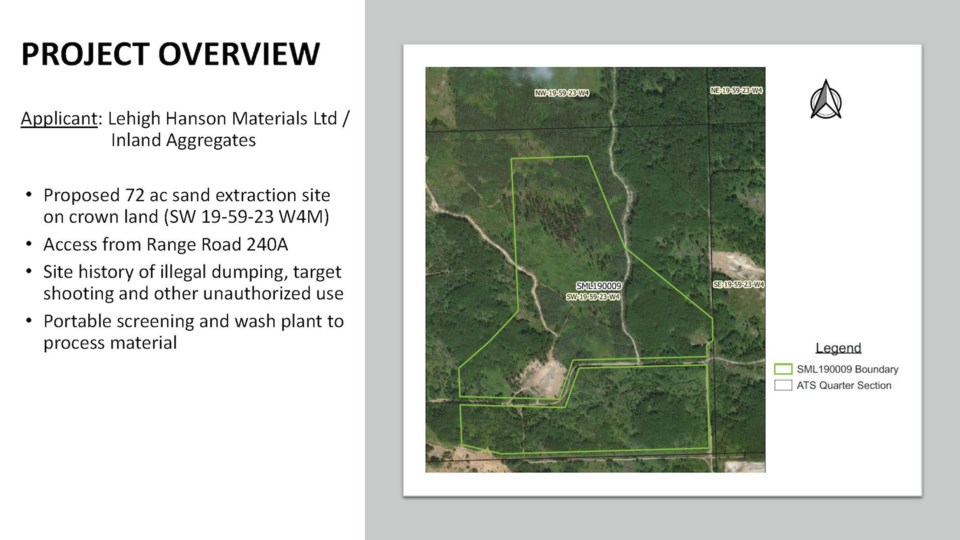WESTLOCK - The Echo Lake area sand pit dubbed a ‘war zone’ due to rampant illegal shooting, dumping and quadding and the site of a 10-acre wildfire in April 2021 which officials say was caused by an abandoned campfire, is on the cusp of becoming a 70-plus-acre sand-extraction development run by Lehigh Hanson Materials Ltd., an international conglomerate which is one of the largest building materials suppliers in North America.
Lehigh Hanson has already secured a 10-year surface material lease (SML) from the province for the 72-acre Crown land site (SW 19-59-23 W4M), a Water Act licence for potential aggregate washing and Historical Resources Act clearance as there are no archaeological resources concerns. The company applied for a municipal development permit from Westlock County in April, with interim CAO Pat Vincent saying recently he expects it to be back in front of the municipal planning commission at its Aug. 24 meeting.
“They’ve gone through all the preliminary steps that we wanted them to do and they’ve adjusted their plans accordingly. I think it will be pretty smooth for them to proceed and get approval from the MPC, although I certainly don’t want to speak on behalf of the MPC,” said Vincent July 26. “But from my perspective, from what I've seen, the work they’ve done and the responses they’ve provided, it should be a pretty straightforward application that comes before the MPC.”
According to a 14-page information package circulated to 23 area landowners within an 800-metre radius of the lease and provided to the Westlock News by Jessica Sabell, Lehigh environment manager for the northern prairies, site development is anticipated to start in 2023 while the facility will be operational up to six months a year on average, with market conditions leading to “increased activity some years.”
Sabell said July 27 they had initially planned for a July 11 virtual open house but found most residents were more comfortable contacting her directly via phone, QR code or e-mail — she said her public consultation summary will be back in the county’s hands Aug. 4. Subsequently, due to the input she’s received, the company has altered the haul route which will see trucks head north on to Range Road 240A, turn right at the fork on to Township Road 593A, then continue east or west on Highway 18 depending on final product destination. Sabell has also learned that many operators head south to Township Road 590 before ending up on Highway 2 and she will be submitting that route to the county which will give them “operational flexibility” and “ideally spread out who’s having trucks go by their house so they’re not all concentrated going north.”
“I think we had 10 of the 23 households respond as no one attended the virtual open house and everyone chose the other options,” she said, noting 90 per cent of the feedback they received were about the haul routes. “Most people said they were neutral or supportive generally of business or development so nobody was drastically opposed to the industry. And a few people did specifically comment that the area has been problematic and it will be good to have a permanent presence there.
“In our experience it’s hard to deter that kind of activity (shooting, dumping) once people have started there as they get used to using a certain area. So, we’re hopeful we’ll be able to curb that relatively quickly.”
Site activities by the company will include overburden stripping; stockpiling product, reclamation and reject materials; material extraction; material processing including screening and washing; hauling/sales and finally, reclamation. The site will not be operational during the winter although some hauling may occur and once they’re done the land be reclaimed to “upland habitat.” Ultimately, the sand extracted will be used to make concrete.
“The SML and Water Act permits are valid for 10 years, so after 10 years we’d have to do those again if we want to continue operating,” Sabell explained, noting most municipal development permits last for five years.
The pit’s life is tabbed at 15 years and a “conservative scenario” anticipates a maximum of 130-haul trucks daily and five employee vehicles “during peak operation only” if they need to haul product to an off-site location as “washing on-site could reduce the number of trucks.”
“We always provide a conservative estimate because that’s what our road-use agreement will be based on. That’s probably a very outside number and it’s not likely that we would be at that max number,” said Sabell on the 130-haul truck number. “It’s also not a plant that will be operating year-round, so there might be peak periods where we’re moving sand out of there and the rest of the year the facility would be relatively quiet. So, 130 is definitely a conservative number for the sake of our permitting and not likely what would be seen on a daily basis.”
Two washing scenarios are being considered by the company: a portable wash plant may be brought to the site with a groundwater well providing water, or screened material will be hauled to an off-site wash plant for final processing, stockpiling and sale.
If washing is done on-site, the water will come from an aquifer and its use is licensed through Alberta Environment and Parks. The presentation notes there’s been an “extensive hydrogeological study (72-hour pump test) completed” and the licence is for a maximum use of 50,000 m3 annually and a daily maximum of 137 m3. The company says freshwater use is minimized in the wash process and a lined pond will be constructed and filled with water recirculated through the system.
Freshwater will only be used to top-up the pond as needed to offset water loss in product and from evaporation. The presentation also notes that actual water use will be reported to AEP monthly and the monitoring of local wells is an option “if there are concerns with water-quantity impacts.”



